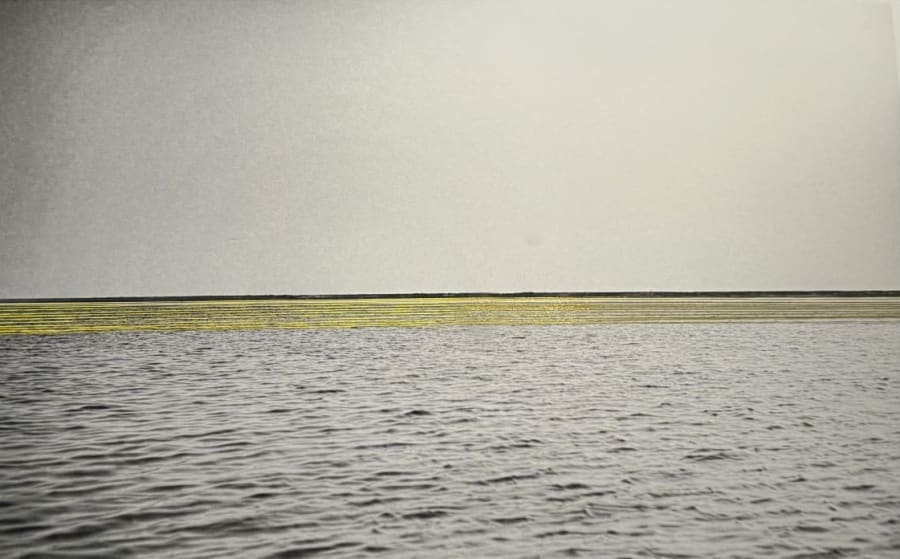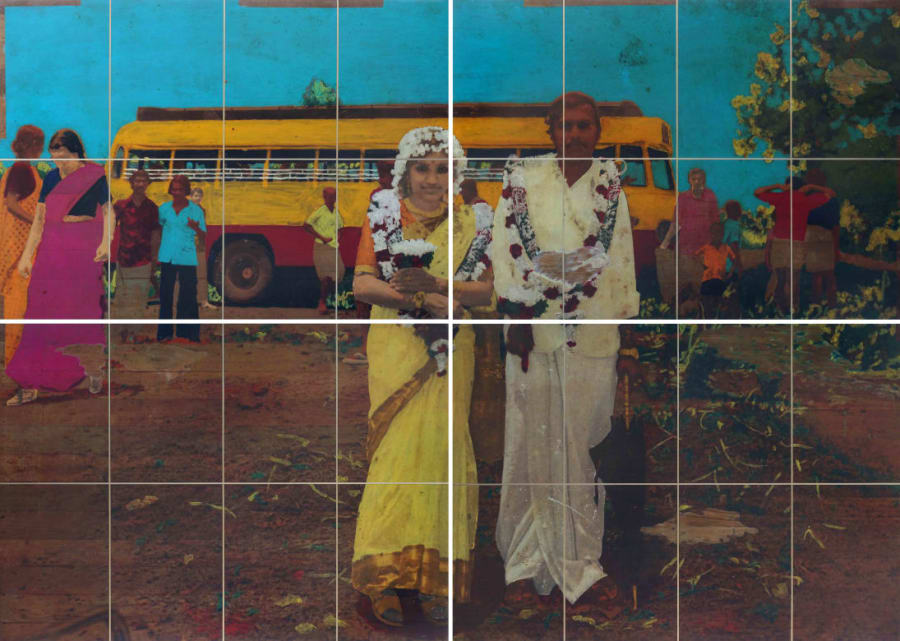Along the highway to Khor Fakkan, the landscape changes from dusty beige to the shade of milky tea, punctuated by tufts of native weeds, before it turns into gravel. This city on the east coast of the UAE, facing the Gulf of Oman, is known for its beautiful coral reefs and beaches nestled between mountains, some of which contain petroglyphs and rock art from the Bronze Age. There are areas amidst these historic remains that quite possibly only Mohamed Ahmed Ibrahim knows – and that he likes to frequent alone. In cooler months, it’s not unusual for him to disappear into nature for a week or two ‘to refresh.’ ‘You’re with yourself, you allow the wind to touch your skin, light a fire, and just be still,’ he says. ‘I unlock memories, meditate, and listen – I mean really listen.’ This is the Emirati artist’s birthplace, and where he has lived for most of his 60+ years. Khor Fakkan forms the backdrop to his multidisciplinary practice and in many ways, it is the key to Ibrahim’s work. He’s made up his own petroglyphs and repeats them on canvas and in sculptures of varying sizes, sometimes using earthy tones, other times in bright colors – as though his entire body of work was one long epic, just waiting to be transcribed.
Warm and jovial, one could be forgiven for likening him to a retired rockstar – the grays and whites in his wavy shoulder-length hair, the white goatee, and his round tinted glasses give him that air, as does the Harley-Davidson leather waistcoat that hangs in his studio. He shares the space with his cats, Shagoori and Lily, whose preferred scratch post is one side of the beaten-up gray couch. Ibrahim has just returned from a five-month trip to Holland, Italy, and Thailand. ‘I was away until I got homesick,’ he laughs, and goes on to share with me, with almost childlike glee, his recent acquisition: a limited-edition motorcycle. Ibrahim has been riding motorbikes since 1994, when, during a trip to The Netherlands (that led to the first exhibition of visual art from the Emirates in Europe a year later at the Sittard Art Centre), he found himself mesmerized by the city’s now-defunct Hells Angels motorcycle club, and promptly rented a motorbike. Something clicked and he started putting money aside to buy one. Then, one day, he walked into a supermarket in Khor Fakkan and found that Camel was holding a raffle to win a Harley-Davidson. ‘I decided that bike was mine,’ laughs Ibrahim, who bought dozens of packets of Camel cigarettes in exchange for raffle tickets and went onto win the motorbike. He quit the Harley-Davidson UAE chapter in 2015, and now does 6–8 hour rides alone to the Eastern city of Al Ain and back. ‘It’s like meditation,’ he says. ‘After a little while, you feel like you’re flying and forget that you’re actually on the bike.’
Ibrahim goes on to mention the smells along the way, such as shisha and bakhoor (incense), each of which acts as a geographic coordinate on his route. His eyes light up when he talks about the scent of certain trees and desert plants. Since he was a boy, Ibrahim has had a deep fondness for potting plants, finding joy in nurturing them and watching them grow. He points to the garden adjacent to his studio and recounts the story of each tree, sounding, in the process, like quite the botanical expert.
‘Al Ain is like Khor Fakkan,’ he says. ‘It’s calm, beautiful, intimate. It’s my second home.’ Ibrahim spent a few years in the ‘garden city’ of the UAE while enrolled at the Abu Dhabi Police School and when studying psychology at Al Ain University between 1980–85. ‘Psychology became a base for my thoughts and my work, and helped me understand things and people better,’ he says. ‘I got closer to myself.’ During this time, he met with actors and writers and read voraciously on art – something he credits to a brother-in-law who studied in the UK and who would regularly send him books. Though he took English at school, Ibrahim relied on the dictionary to understand the content. ‘Sometimes it would take a whole day to translate one page,’ he recalls. ‘One wrong word and you could misunderstand the whole thing!’
Ibrahim always knew that art was his calling and he learnt painting techniques in 1985 in a workshop hosted in Sharjah by Jordan-based Palestinian artist Yaser Dweik. Around this time, he became curious about the rocks around his beloved Khor Fakkan, turning them and exploring their colors and surfaces. He just didn’t know it was called Land art. From 2007, he often wrapped them in copper wire, and went on to create Falling Stones Garden in Al Ula in Saudi Arabia as part of Desert X in 2020, choosing ‘to add to, not distort’ the landscape with 320 brightly colored stones.
After the workshop with Dweik, Ibrahim met the late Hassan Sharif, known as the father of Conceptual art in the Emirates. Together, they staged exhibitions and along with a few others, laid the groundwork for what has grown into a thriving scene. ‘We were each other’s strengths,’ says Ibrahim, who along with Sharif, Abdullah Al Saadi, Mohammed Kazem, and Hassan’s brother, Hussain, were known as the Five – a group of Conceptual artists, who were largely misunderstood and isolated. ‘The rejection or lack of understanding didn’t put me off at all. It just made me more determined,’ says Ibrahim. ‘We placed our bets on the youth, and we knew it was important to change the minds of our own community. It paid off! Look what happened later with public and private support.’
His papier-mâché sculptures imbue his studio with a sense of otherworldly presence, as though we were not the only beings there. A surreal feeling arises when Ibrahim points to the rolls and stacks of cardboard that form their skeletal frameworks. The canvases on the easels mirror the sculptures: It is clear they are the same works in 2D and 3D form. These are his own petroglyphs, which have found their way onto the canvas from the space between his eye and eyelid. ‘You don’t stop seeing when you close your eyes,’ he explains. ‘In that space, there’s another space, and in there, things are born and created and that’s where I see these shapes. And the colors change if I am in sunlight or darkness.’ He insists that, just like muscles have memory, the eye stores and remembers too. Perhaps the sights of Khor Fakkan’s petroglyphs are burnt into his retina.
One easel displays a painting in progress featuring text – a new addition for Ibrahim. ‘I used to stick to Untitled intentionally, to leave things to the viewer’s imagination, but I realized that’s enough,’ he laughs, pointing to Two Clouds and the Night Sky in Bangkok (2025), which is inscribed with Arabic text. ‘It’s a bit of a command and I like telling people what to think.’ This month, Between Sunrise and Sunset (2022), his installation for the UAE National Pavilion at the Venice Biennale in 2022 will be shown at the Maraya Art Centre in Sharjah. Some have said the single work comprising dozens of different sized multicolored sculptures is best viewed when squinting. ‘If you squeeze your eyelid, you’ll create different shapes, just as you would if you relaxed that eyelid,’ says Ibrahim. ‘That’s the work: practice.’
Mohamed Ahmed Ibrahim is represented by Lawrie Shabibi (Dubai).
For over two decades, Myrna Ayad has authored, edited, and contributed to several books, magazines, and dailies on visual art and culture from the Arab world and Iran. A frequent panelist, jurist, and moderator, her role as an independent cultural strategist allows her to work on projects within the luxury sector, government entities, private companies, and non-profit organizations. Based in the UAE for over four decades, Ayad is a graduate of the American University in Dubai and lives in Dubai with her husband and two children.
Top image: Mohammed Ahmed Ibrahim, Falling Stones Garden, 2020. Installation view at Desert X AlUla. Photo by Lance Gerber. Courtesy of the artist and Lawrie Shabibi, RCU and Desert X.
Published on February 21, 2025.


